北师大版(2019)选择性必修第二册Unit 5 Education Viewing Workshop 课件(27张ppt)
文档属性
| 名称 | 北师大版(2019)选择性必修第二册Unit 5 Education Viewing Workshop 课件(27张ppt) | 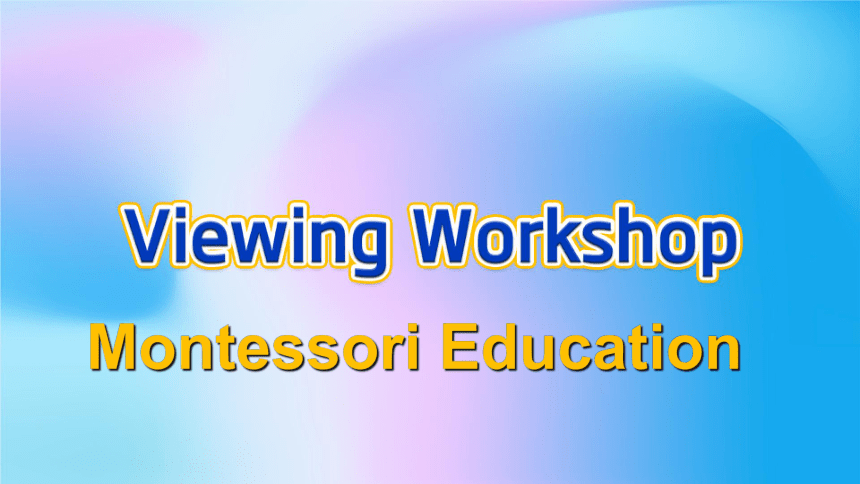 | |
| 格式 | zip | ||
| 文件大小 | 4.1MB | ||
| 资源类型 | 教案 | ||
| 版本资源 | 北师大版(2019) | ||
| 科目 | 英语 | ||
| 更新时间 | 2021-11-28 15:36:25 | ||
图片预览


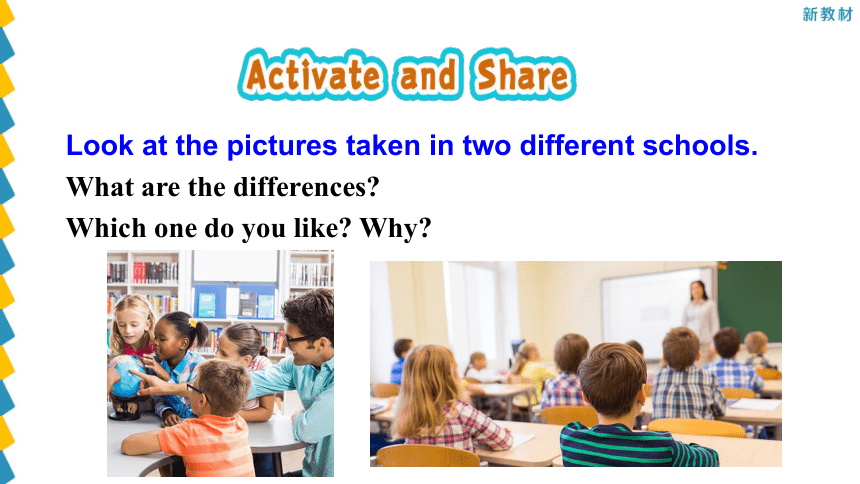
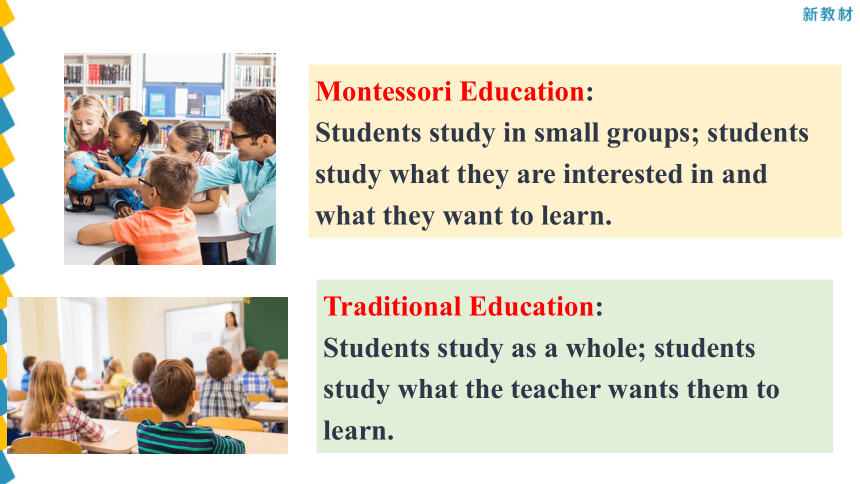
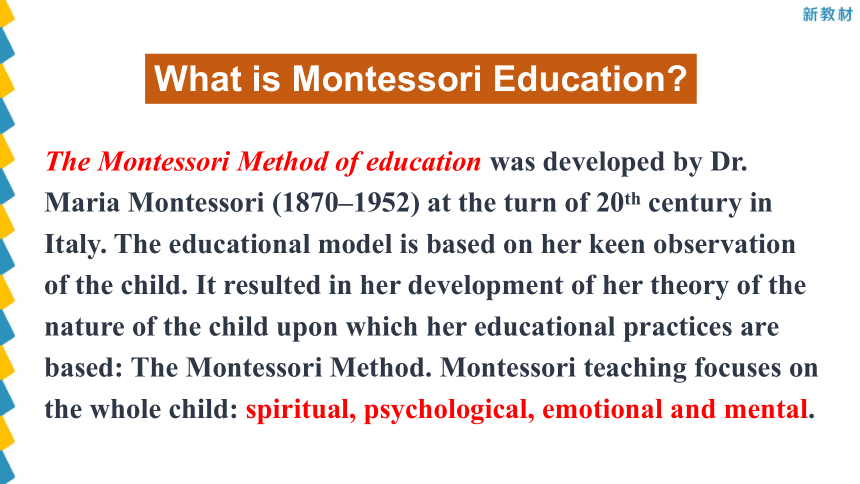
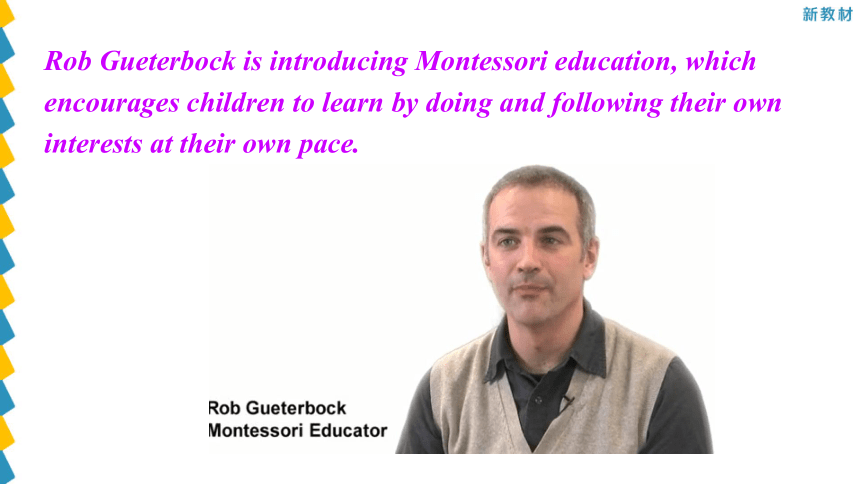
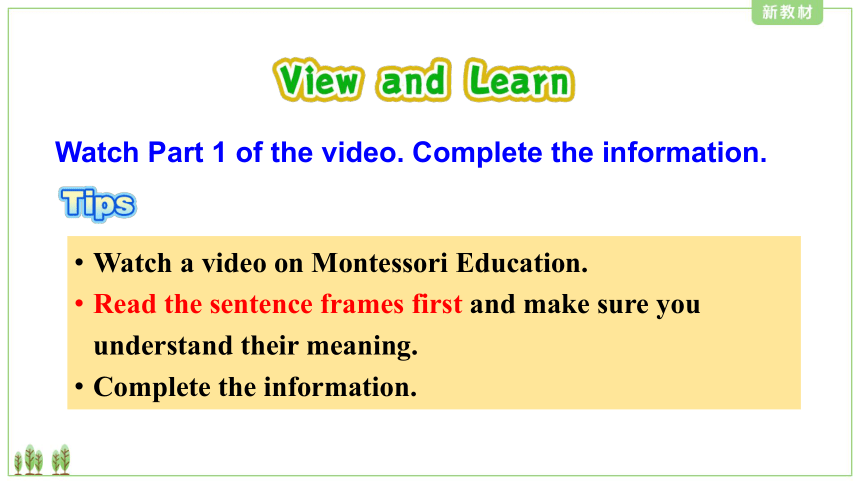
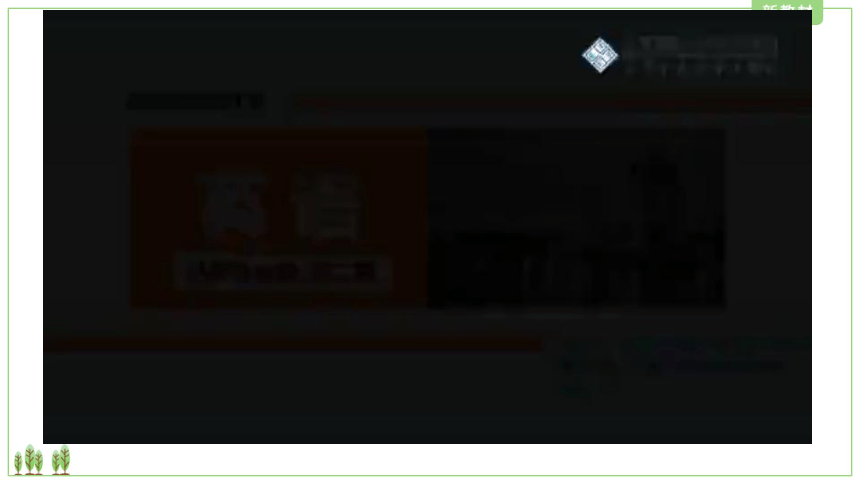

文档简介
(共27张PPT)
Montessori Education
To watch a video about Montessori Education.
To view for understanding.
To summarize information.
Look at the pictures taken in two different schools.
What are the differences
Which one do you like Why
Montessori Education:
Students study in small groups; students study what they are interested in and what they want to learn.
Traditional Education:
Students study as a whole; students study what the teacher wants them to learn.
The Montessori Method of education was developed by Dr. Maria Montessori (1870–1952) at the turn of 20th century in Italy. The educational model is based on her keen observation of the child. It resulted in her development of her theory of the nature of the child upon which her educational practices are based: The Montessori Method. Montessori teaching focuses on the whole child: spiritual, psychological, emotional and mental.
What is Montessori Education
Rob Gueterbock is introducing Montessori education, which encourages children to learn by doing and following their own interests at their own pace.
Watch Part 1 of the plete the information.
Watch a video on Montessori Education.
Read the sentence frames first and make sure you understand their meaning.
Complete the information.
Rob Gueterbock is a Montessori _______. He’s been working with children for _______. He did so for two reasons. First, he ________________ the journey that each one has made, from a small cell to a ________, ________, _________, adult human being; and secondly, it’s just _______________ to spend a day to see the children working so independently and __________ as a community of human beings working together.
guide
7 years
was fascinated by
complex
walking
talking
a beautiful way
functioning
Watch Part 2 of the video. Write T (true) or F (false).
Watch the second part of the video.
Discuss the statements.
In groups, discuss what you think the answers will be.
( ) 1. Children don’t want to learn by themselves.
( ) 2. Children want to explore the world around them.
( ) 3. Children don’t want to learn things that are told to them.
( ) 4. Children learn best when they’re following their own interests.
( ) 5. Children don’t learn by doing, but by listening or talking.
F
T
T
T
F
Watch Part 3. What are the differences between Montessori education and traditional education Put the features (a-i) into the right columns.
The table is contrasting the two types of education. Place the statements in the correct column.
Watch part 3 of the video.
In pairs, compare Montessori education with traditional education.
Montessori education and traditional education
Montessori Features Traditional
Children experience learning at their own pace.
Lessons are done in a whole class.
Children are banded by age.
Children learn in mixed-age communities.
Value cooperation. f. Encourage competition.
g. Lessons tend to be individual or in small groups.
h. They use the word “teacher” instead of “guide”.
i. Teaching begins with a curriculum.
a
d
e
g
i
b
c
f
h
i
The fundamental principle of Maria Montessori’s method is to value a child’s naturally inquisitive (好追根究底的) and developing mind to help learning in an intuitive (直觉的) and natural way.
Environment
Montessori classrooms are prepared thoughtfully in a way that encourages learners to explore for themselves. Students are guided to make their own discoveries, as well as gain a sense of independence. The teacher is to provide help.
Learn more
Development
The Montessori teaching seeks to maximize development at a healthy pace. Younger students may learn with older students, while the older students help solidify(使巩固) ideas by teaching them to younger students. This way, no child is limited by his/her age group, and every student has opportunities to learn.
Materials
The materials chosen are carefully considered, both for fostering peer learning and for providing an pleasing environment.
Watch Part 4 of the video. What stages of education can the Montessori Method be applied on What does Rob mean by “If we give children active toys, then we end up with passive children”
In the UK, most Montessori schools are pre-school, there are some primary schools. But in America and in other parts of the world, there are Montessori secondary schools that go all the way through to 18.
Active toys stop children to create by themselves and children would be passive.
Passive toys give children space to be active, and that leads to active children.
What are the advantages of Montessori education
What are the possible drawbacks
Discuss with your partner.
Hands-on learning which leads to better understanding.
Positive social interaction and acquiring of social skills.
Independent learning which breeds responsibility and a love for learning.
Inclusive of different students’ needs.
It is not accessible for everyone.
The curriculum is not structured enough for some students.
The open-ended structure of the classroom can be intimidating for some students.
Montessori Education
Traditional Education
Add some words to create a word web on the two types of schools.
Work in pairs, discuss which is your favorite and the reasons.
Montessori Education
Traditional Education
Students study in small groups;
Students study what they are interested in and what they want to learn.
Students study as a whole;
Students study what the teacher wants them to learn.
Children unaided (独力的) can construct an orderly society. For us adults, prisons, police, soldiers and guns are necessary. Children solve their problems peacefully.
—Maria Montessori
List the features of Montessori Education and Traditional Education.
Montessori Education
To watch a video about Montessori Education.
To view for understanding.
To summarize information.
Look at the pictures taken in two different schools.
What are the differences
Which one do you like Why
Montessori Education:
Students study in small groups; students study what they are interested in and what they want to learn.
Traditional Education:
Students study as a whole; students study what the teacher wants them to learn.
The Montessori Method of education was developed by Dr. Maria Montessori (1870–1952) at the turn of 20th century in Italy. The educational model is based on her keen observation of the child. It resulted in her development of her theory of the nature of the child upon which her educational practices are based: The Montessori Method. Montessori teaching focuses on the whole child: spiritual, psychological, emotional and mental.
What is Montessori Education
Rob Gueterbock is introducing Montessori education, which encourages children to learn by doing and following their own interests at their own pace.
Watch Part 1 of the plete the information.
Watch a video on Montessori Education.
Read the sentence frames first and make sure you understand their meaning.
Complete the information.
Rob Gueterbock is a Montessori _______. He’s been working with children for _______. He did so for two reasons. First, he ________________ the journey that each one has made, from a small cell to a ________, ________, _________, adult human being; and secondly, it’s just _______________ to spend a day to see the children working so independently and __________ as a community of human beings working together.
guide
7 years
was fascinated by
complex
walking
talking
a beautiful way
functioning
Watch Part 2 of the video. Write T (true) or F (false).
Watch the second part of the video.
Discuss the statements.
In groups, discuss what you think the answers will be.
( ) 1. Children don’t want to learn by themselves.
( ) 2. Children want to explore the world around them.
( ) 3. Children don’t want to learn things that are told to them.
( ) 4. Children learn best when they’re following their own interests.
( ) 5. Children don’t learn by doing, but by listening or talking.
F
T
T
T
F
Watch Part 3. What are the differences between Montessori education and traditional education Put the features (a-i) into the right columns.
The table is contrasting the two types of education. Place the statements in the correct column.
Watch part 3 of the video.
In pairs, compare Montessori education with traditional education.
Montessori education and traditional education
Montessori Features Traditional
Children experience learning at their own pace.
Lessons are done in a whole class.
Children are banded by age.
Children learn in mixed-age communities.
Value cooperation. f. Encourage competition.
g. Lessons tend to be individual or in small groups.
h. They use the word “teacher” instead of “guide”.
i. Teaching begins with a curriculum.
a
d
e
g
i
b
c
f
h
i
The fundamental principle of Maria Montessori’s method is to value a child’s naturally inquisitive (好追根究底的) and developing mind to help learning in an intuitive (直觉的) and natural way.
Environment
Montessori classrooms are prepared thoughtfully in a way that encourages learners to explore for themselves. Students are guided to make their own discoveries, as well as gain a sense of independence. The teacher is to provide help.
Learn more
Development
The Montessori teaching seeks to maximize development at a healthy pace. Younger students may learn with older students, while the older students help solidify(使巩固) ideas by teaching them to younger students. This way, no child is limited by his/her age group, and every student has opportunities to learn.
Materials
The materials chosen are carefully considered, both for fostering peer learning and for providing an pleasing environment.
Watch Part 4 of the video. What stages of education can the Montessori Method be applied on What does Rob mean by “If we give children active toys, then we end up with passive children”
In the UK, most Montessori schools are pre-school, there are some primary schools. But in America and in other parts of the world, there are Montessori secondary schools that go all the way through to 18.
Active toys stop children to create by themselves and children would be passive.
Passive toys give children space to be active, and that leads to active children.
What are the advantages of Montessori education
What are the possible drawbacks
Discuss with your partner.
Hands-on learning which leads to better understanding.
Positive social interaction and acquiring of social skills.
Independent learning which breeds responsibility and a love for learning.
Inclusive of different students’ needs.
It is not accessible for everyone.
The curriculum is not structured enough for some students.
The open-ended structure of the classroom can be intimidating for some students.
Montessori Education
Traditional Education
Add some words to create a word web on the two types of schools.
Work in pairs, discuss which is your favorite and the reasons.
Montessori Education
Traditional Education
Students study in small groups;
Students study what they are interested in and what they want to learn.
Students study as a whole;
Students study what the teacher wants them to learn.
Children unaided (独力的) can construct an orderly society. For us adults, prisons, police, soldiers and guns are necessary. Children solve their problems peacefully.
—Maria Montessori
List the features of Montessori Education and Traditional Education.
同课章节目录
- Unit 4 Humour
- Lesson 1 What’s So Funny?
- Lesson 2 Why Do We Need Humour?
- Lesson 3 My Favourite Comedian
- Unit 5 Education
- Lesson 1 Enlightening a Mind
- Lesson 2 The Objectives of Education
- Lesson 3 Understanding
- Unit 6 The Media
- Lesson 1 From Page to Screen
- Lesson 2 Questions about Media
- Lesson 3 The Advertising Game
